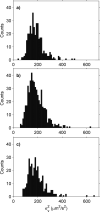Rapid morphological characterization of isolated mitochondria using Brownian motion
- PMID: 26435755
- PMCID: PMC4590767
- DOI: 10.1039/C2AY05686K
Rapid morphological characterization of isolated mitochondria using Brownian motion
Abstract
Mitochondrial morphology has been associated with numerous pathologies including cancer, diabetes, obesity and heart disease. However, the connection is poorly understood-in part due to the difficulty of characterizing the morphology. This impedes the use of morphology as a tool for disease detection/monitoring. Here, we use the Brownian motion of isolated mitochondria to characterize their size and shape in a high throughput fashion. By using treadmill exercise training, mitochondria from heart and gastrocnemius of Balb/c mice were modulated in size and used to investigate the protocol. Consistent with previous reports, the heart mitochondria of untrained mice increased 5% in diameter immediately after a single bout of moderate exercise (1.091 ± 0.004 μm) as compared to completely sedentary controls (1.040 ± 0.022 μm). In addition, no change was observed in the size of gastrocnemius mitochondria (1.025 ± 0.018 μm), which was also in agreement with previous studies. The method was also successfully applied to smaller Saccharomyces cerevisiae mitochondria.
Figures







References
-
- DiMauro S, Hirano M, Schon EA, editors. Mitochondrial Medicine. Informa Healthcare; Andover: 2006.
-
- Brunk UT, Terman A. Eur. J. Biochem. 2002;269:1996–2002. - PubMed
-
- Kelley DE, He J, Menshikova EV, Ritov VB. Diabetes. 2002;51:2944–2950. - PubMed
-
- Shen X, Zheng S, Thongboonkerd V, Xu M, Pierce WM, Klein JB, Epstein PN. Am. J. Physiol.: Endocrinol. Metab. 2004;287:E896–E905. - PubMed
-
- Modica-Napolitano JS, Singh K. Expert Rev. Mol. Med. 2002;4:1–19. - PubMed
Grants and funding
LinkOut - more resources
Full Text Sources
Molecular Biology Databases

